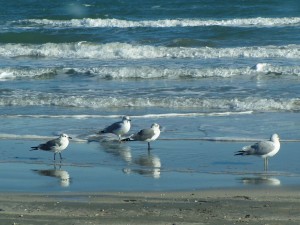They’re loud and demanding and messy.
I AM NOT talking about my grandchildren. I’m talking about seagulls.
 Last week we were on the Gulf Coast of Florida taking a few days of R & R before we were to lead a choir retreat nearby. We spent a couple of days just sitting on the beach watching the waves and the dolphins roll in and out of our view. And though I’ve been to the beach many times, I always learn something each time I go. (Maybe it’s because I choose to look for something new.) Anyway, this time I chose to watch and learn from the seagulls.
Last week we were on the Gulf Coast of Florida taking a few days of R & R before we were to lead a choir retreat nearby. We spent a couple of days just sitting on the beach watching the waves and the dolphins roll in and out of our view. And though I’ve been to the beach many times, I always learn something each time I go. (Maybe it’s because I choose to look for something new.) Anyway, this time I chose to watch and learn from the seagulls.
They’re scavengers, no doubt, and they find no shame in begging for morsels from unsuspecting beachcombers. Reflection. Don’t throw out anything edible if you don’t want to reenact a horror scene from a Hitchcock movie. This I already knew from experience.
Observation. Seagulls are almost always found in flocks. You hardly ever see one alone (no matter what the book Jonathan Livingston Seagull implies). Sometimes it’s a small flock, sometimes a huge herd. But I knew that, too.
Lesson learned. I realized for the first time this time that all seagulls in a flock, while on the ground, face in the same direction. It was funny at first. A single gull might fly off for a few minutes, then return and resume the position as if compelled to fit in or because he was being careful not to ruffle the feathers of the alpha male or a higher-up in the pecking order. Was it east or west or what that lined them up facing one way?
Finally it dawned on me. They all seemed to face into the wind.
When I got home, I did a little research and found that this was exactly what they were doing. It was the wind that determined their direction and for a bird of flight that is important. Seagulls need to vacate the beach quickly when danger arrives or when a food source suddenly becomes available. If their tail feathers are facing the wind they would be less aerodynamic and more in danger of getting saltwater, sand, or debris under their perfectly designed down and feather covering. It just makes sense. They protect themselves from harm and they are always ready for flight by leaning into the wind.
I know that eagles can soar to great heights and like Isaiah tells us “those who trust in the Lord will renew their strength; they will soar on wings like eagles.”
I know that ducks can fly long distances but not necessarily so high. (That’s maybe why they are sometimes easy shots.) However, you have to give them something for endurance. Like James says, “Consider it a great joy, my brothers, whenever you experience various trials, knowing that the testing of your faith produces endurance.”
Eagles fly high and so do I sometimes. Ducks fly far and often perseverance is required of me.
But seagulls stand on the shore, feel the wind on their beaks, and wait for the next thing.
Right now, I’m not really soaring to great heights or flapping furiously for distance. I’m kind of…waiting…leaning into the wind a little, and trying to turn as the wind changes, ready for whatever is coming. And watching the gulls last week I know that I’m not alone. There are others in the same place as I.
Nan,
Excellent observations! Love it when the “every day” becomes a “God moment”. You lead there with great ease & grace.
thanks
Lindsey
Hey Nan!
Just a note to let you know I was encouraged (and informed about new seagull factoids) through the reading of your blog. I pray you and D-diddy had a restful time down on the beach. See you soon!
Blessings,
Bruce
I am at this place as well. Thank you for the scriptures!!!